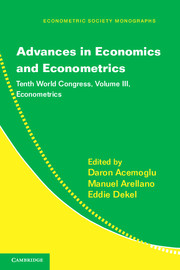Book contents
- Frontmatter
- Contents
- Contributors
- Preface
- I ECONOMETRICS OF INDUSTRIAL ORGANIZATION
- II MACROECONOMETRICS
- 4 Macroeconomics and Volatility: Data, Models, and Estimation
- 5 Estimation and Evaluation of DSGE Models: Progress and Challenges
- 6 Discussion of Fernández-Villaverde and Rubio-Ramírez as well as Schorfheide
- III ECONOMETRIC THEORY
- IV EMPIRICAL MICROECONOMICS
- V TIME SERIES AND PANELS
- VI MIRRLEES REVIEW: RETHINKING THE TAX SYSTEM FOR THE TWENTY-FIRST CENTURY
- Name Index
- Miscellaneous Endmatter
4 - Macroeconomics and Volatility: Data, Models, and Estimation
Published online by Cambridge University Press: 05 May 2013
- Frontmatter
- Contents
- Contributors
- Preface
- I ECONOMETRICS OF INDUSTRIAL ORGANIZATION
- II MACROECONOMETRICS
- 4 Macroeconomics and Volatility: Data, Models, and Estimation
- 5 Estimation and Evaluation of DSGE Models: Progress and Challenges
- 6 Discussion of Fernández-Villaverde and Rubio-Ramírez as well as Schorfheide
- III ECONOMETRIC THEORY
- IV EMPIRICAL MICROECONOMICS
- V TIME SERIES AND PANELS
- VI MIRRLEES REVIEW: RETHINKING THE TAX SYSTEM FOR THE TWENTY-FIRST CENTURY
- Name Index
- Miscellaneous Endmatter
Summary
Introduction
Macroeconomics is concerned with the dynamic effects of shocks. For instance, the real-business-cycle research program originated with an investigation of the consequences of changes in productivity (Kydland and Prescott 1982). Later, the new generation of monetary models of the late 1990s and early 2000s was particularly focused on shocks to monetary policy (Christiano, Eichenbaum, and Evans 2005). In open macroeconomics, considerable attention was devoted to shocks to the interest rate (Mendoza 1991) or to the terms of trade (Mendoza 1995). Similar examples can be cited from dozens of other subfields of macroeconomics, from asset pricing to macro public finance: Researchers postulate an exogenous stochastic process and explore the consequences for prices and quantities of innovations to it.
Traditionally, one key feature of these stochastic processes was the assumption of homoscedasticity. More recently, however, economists started to relax this assumption. In particular, they considered shocks to the variance of the innovations of the processes. A first motivation for this new research comes from the realization that time-series have a strong time-varying variance component. The most famous of those episodes is the great moderation of aggregate fluctuations in the United States between 1984 and 2007, when real aggregate volatility fell by around one third and nominal volatility by more than half. A natural mechanism to generate these changes is to have shocks that also have a time-varying volatility and to trace the effects of changes in volatility on aggregate dynamics.
Information
- Type
- Chapter
- Information
- Advances in Economics and EconometricsTenth World Congress, pp. 137 - 183Publisher: Cambridge University PressPrint publication year: 2013
Accessibility standard: Unknown
Why this information is here
This section outlines the accessibility features of this content - including support for screen readers, full keyboard navigation and high-contrast display options. This may not be relevant for you.Accessibility Information
- 17
- Cited by
